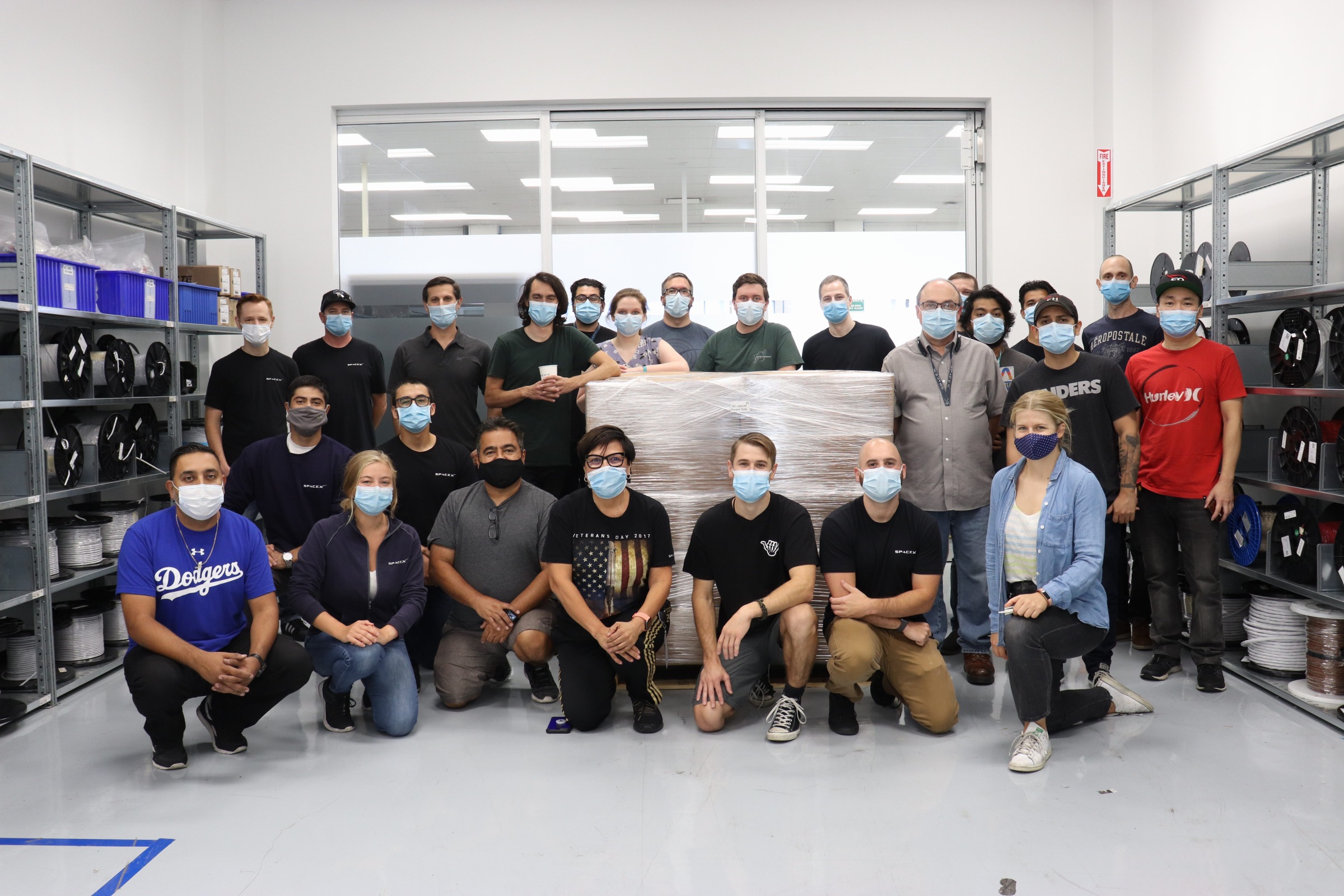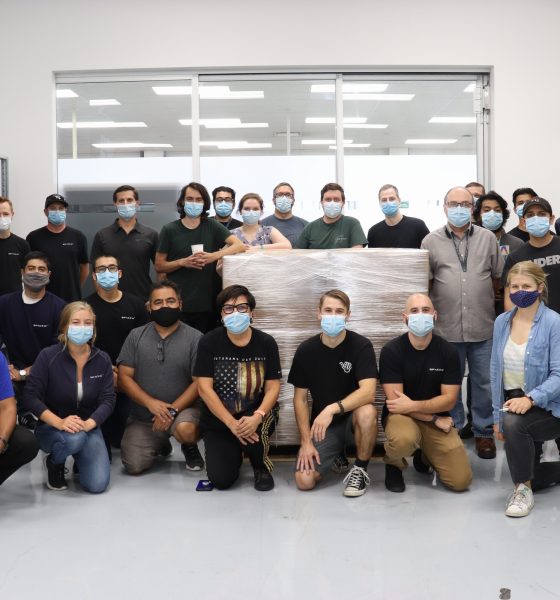

News
Medtronic opens up about Elon Musk and SpaceX’s role in fight against COVID-19
Earlier this year, Elon Musk announced on Twitter that SpaceX would be working with medical device firm Medtronic to help the company produce its most advanced ventilators, which are pivotal in the battle against the pandemic. Details about the two companies’ collaboration have been quite slim since then, with Musk simply noting that SpaceX was producing valves for Medtronic.
In a recent post, Medtronic opted to share some key insights about its work with Elon Musk and his private space enterprise. The medical device maker’s story highlighted the value of Musk’s Silicon Valley-style approach to his companies, which emphasizes quick innovation that’s directed towards the development of real-world, practical solutions in the shortest time possible.
Medtronic’s Puritan Bennett 980 Ventilator Series is the company’s most advanced ventilator. It allows patients to breathe naturally through a series of innovative breath delivery technologies. It’s also fitted with a unique ventilator assistance feature that allows the machine to continue delivering ventilatory support even in the event of certain system failures. The flagship machine is built in Medtronic’s facility in Galway, Ireland, and it has become a staple in numerous hospitals.
In a typical year, Medtronic’s Galway plant could produce about 7,500 valves for its flagship ventilator. But with COVID-19 spreading across the globe, the need for ventilators increased rapidly and significantly. Medtronic promptly increased the production of its ventilators, and by mid-March, the Galway plant had raised its output by 40%. But it was not enough. Building ventilators is a complex process, after all, and the machines require advanced components that are difficult to manufacture.
One of these components is a proportional solenoid (PSOL) valve, a highly complex piece of machinery that controls the flow of air and oxygen inside the machine. The PSOL valve consists of over 50 parts, and each must be manufactured with surgical precision, with some components having tolerances as thin as a strand of hair. Medtronic’s most advanced ventilator used three of these PSOL valves per unit, and as noted by Medtronic Engineer Matt Phillips, the medical device firm was pretty much at a loss about how it could meet the increasing demand for its products.
And then Elon Musk called, and he came with a unique, interesting proposal.
Musk’s private space firm, SpaceX, which made its mark in the industry with its reusable rockets and its Crew Dragon spacecraft, offered to make PSOL valves for Medtronic. SpaceX proved to be the perfect partner for the medical device maker, as it already had a division that designs and manufactures valves for its rockets. The private space enterprise’s engineers were top-notch, and they had the technical expertise to stand up to the challenge. And with that, the two companies’ collaboration began.
In a display of its quick, Silicon Valley-style approach to problem-solving, SpaceX did not waste any time. COVID-19 was not letting up, and neither was Elon Musk’s private space enterprise. SpaceX promptly converted part of its rocket factory in Hawthorne, California to produce PSOL valves with the help of Medtronic employees. To maximize mobility and speed, the team even built a PSOL valve manufacturing line on carts. Ultimately, the SpaceX and Medtronic team achieved in months what might have otherwise taken years.
“They literally turned a rocket production area into a ventilator valve manufacturing facility almost overnight,” Phillips said.
As noted by the Medtronics engineer, SpaceX did not scrimp on its talent, with some of the engineers who worked on the Crew Dragon capsule working on the Medtronic project. Quality control was extremely high, with the valves produced at the SpaceX site undergoing rigorous testing before being shipped to Galway.
“We had their best technicians. We had their best engineers. Some of the people working on this project are the very people who just launched the first private commercial crew to the International Space Station. They brought the same kind of energy to this project that they brought to putting astronauts into space,” Phillips noted.
“When it comes down to it, these ventilators are going to save lives,” Phillips said. “So every component has to be perfect. There is no room for error, which is why we put these valves through such an intensive testing protocol,” the Medtronic engineer added.
Thanks in no small part to the quick initiative of the SpaceX team, the medical equipment company now has the capability to produce 9,000 PSOL valves for Medtronic’s flagship ventilator over the next 8 to 10 weeks. That’s about the same amount of valves that Medtronic’s Galway plant produced in 2019. The Galway facility, for its part, could now operate at five times the volume of its pre-pandemic operations.
“I have never seen anything like this in my life… This project certainly changed the way I look at production, partnership, and innovation. I know that, with the right focus and the right energy, we can take what we learned from this project and apply it to other challenges that come our way,” Phillips remarked.

News
Elon Musk’s Grokipedia surges to 5.6M articles, almost 79% of English Wikipedia
The explosive growth marks a major milestone for the AI-powered online encyclopedia, which was launched by Elon Musk’s xAI just months ago.

Elon Musk’s Grokipedia has grown to an impressive 5,615,201 articles as of today, closing in on 79% of the English Wikipedia’s current total of 7,119,376 articles.
The explosive growth marks a major milestone for the AI-powered online encyclopedia, which was launched by Elon Musk’s xAI just months ago. Needless to say, it would only be a matter of time before Grokipedia exceeds English Wikipedia in sheer volume.
Grokipedia’s rapid growth
xAI’s vision for Grokipedia emphasizes neutrality, while Grok’s reasoning capabilities allow for fast drafting and fact-checking. When Elon Musk announced the initiative in late September 2025, he noted that Grokipedia would be an improvement to Wikipedia because it would be designed to avoid bias.
At the time, Musk noted that Grokipedia “is a necessary step towards the xAI goal of understanding the Universe.”
Grokipedia was launched in late October, and while xAI was careful to list it only as Version 0.1 at the time, the online encyclopedia immediately earned praise. Wikipedia co-founder Larry Sanger highlighted the project’s innovative approach, noting how it leverages AI to fill knowledge gaps and enable rapid updates. Netizens also observed how Grokipedia tends to present articles in a more objective manner compared to Wikipedia, which is edited by humans.
Elon Musk’s ambitious plans
With 5,615,201 total articles, Grokipedia has now grown to almost 79% of English Wikipedia’s article base. This is incredibly quick, though Grokipedia remains text-only for now. xAI, for its part, has now updated the online encyclopedia’s iteration to v0.2.
Elon Musk has shared bold ideas for Grokipedia, including sending a record of the entire knowledge base to space as part of xAI’s mission to preserve and expand human understanding. At some point, Musk stated that Grokipedia will be renamed to Encyclopedia Galactica, and it will be sent to the cosmos.
“When Grokipedia is good enough (long way to go), we will change the name to Encyclopedia Galactica. It will be an open source distillation of all knowledge, including audio, images and video. Join xAI to help build the sci-fi version of the Library of Alexandria!” Musk wrote, adding in a later post that “Copies will be etched in stone and sent to the Moon, Mars and beyond. This time, it will not be lost.”
News
Tesla Model 3 becomes Netherlands’ best-selling used EV in 2025
More than one in ten second-hand electric cars sold in the country last year was a Tesla Model 3.

The Tesla Model 3 became the most popular used electric car in the Netherlands in 2025, cementing its dominance well beyond the country’s new-car market.
After years at the top of Dutch EV sales charts, the Model 3 now leads the country’s second-hand EV market by a wide margin, as record used-car purchases pushed electric vehicles further into the mainstream.
Model 3 takes a commanding lead
The Netherlands recorded more than 2.1 million used car sales last year, the highest level on record. Of those, roughly 4.8%, or about 102,000 vehicles, were electric. Within that growing segment, the Tesla Model 3 stood far ahead of its competitors.
In 2025 alone, 11,338 used Model 3s changed hands, giving the car an 11.1% share of the country’s entire used EV market. That means more than one in ten second-hand electric cars sold in the country last year was a Tesla Model 3, Auto Week Netherlands reported. The scale of its lead is striking: the gap between the Model 3 and the second-place finisher, the Volkswagen ID3, is more than 6,700 vehicles.
Rivals trail as residual values shape rankings
The Volkswagen ID.3 ranked a distant second, with 4,595 used units sold and a 4.5% market share. Close behind was the Audi e-tron, which placed third with 4,236 registrations. As noted by Auto Week Netherlands, relatively low residual values likely boosted the e-tron’s appeal in the used market, despite its higher original price.
Other strong performers included the Kia Niro, the Tesla Model Y, and the Hyundai Kona, highlighting continued demand for compact and midsize electric vehicles with proven range and reliability. No other model, however, came close to matching the Model 3’s scale or market presence.
News
Tesla Model Y Standard Long Range RWD launches in Europe
The update was announced by Tesla Europe & Middle East in a post on its official social media account on X.

Tesla has expanded the Model Y lineup in Europe with the introduction of the Standard Long Range RWD variant, which offers an impressive 657 km of WLTP range.
The update was announced by Tesla Europe & Middle East in a post on its official social media account on X.
Model Y Standard Long Range RWD Details
Tesla Europe & Middle East highlighted some of the Model Y Standard Long Range RWD’s most notable specs, from its 657 km of WLTP range to its 2,118 liters of cargo volume. More importantly, Tesla also noted that the newly released variant only consumes 12.7 kWh per 100 km, making it the most efficient Model Y to date.
The Model Y Standard provides a lower entry point for consumers who wish to enter the Tesla ecosystem at the lowest possible price. While the Model 3 Standard is still more affordable, some consumers might prefer the Model Y Standard due to its larger size and crossover form factor. The fact that the Model Y Standard is equipped with Tesla’s AI4 computer also makes it ready for FSD’s eventual rollout to the region.
Top Gear’s Model Y Standard review
Top Gear‘s recent review of the Tesla Model Y Standard highlighted some of the vehicle’s most notable features, such as its impressive real-world range, stellar infotainment system, and spacious interior. As per the publication, the Model Y Standard still retains a lot of what makes Tesla’s vehicles well-rounded, even if it’s been equipped with a simplified interior.
Top Gear compared the Model Y Standard to its rivals in the same segment. “The introduction of the Standard trim brings the Model Y in line with the entry price of most of its closest competition. In fact, it’s actually cheaper than a Peugeot e-3008 and costs £5k less than an entry-level Audi Q4 e-tron. It also makes the Ford Mustang Mach-E look a little short with its higher entry price and worse range,” the publication wrote.








